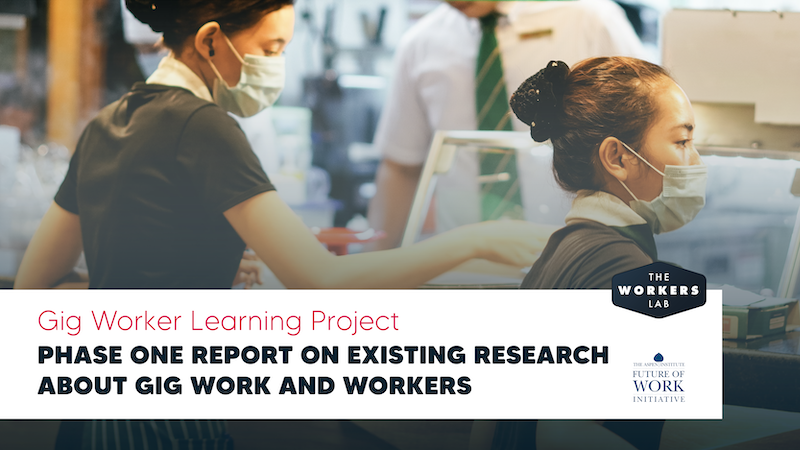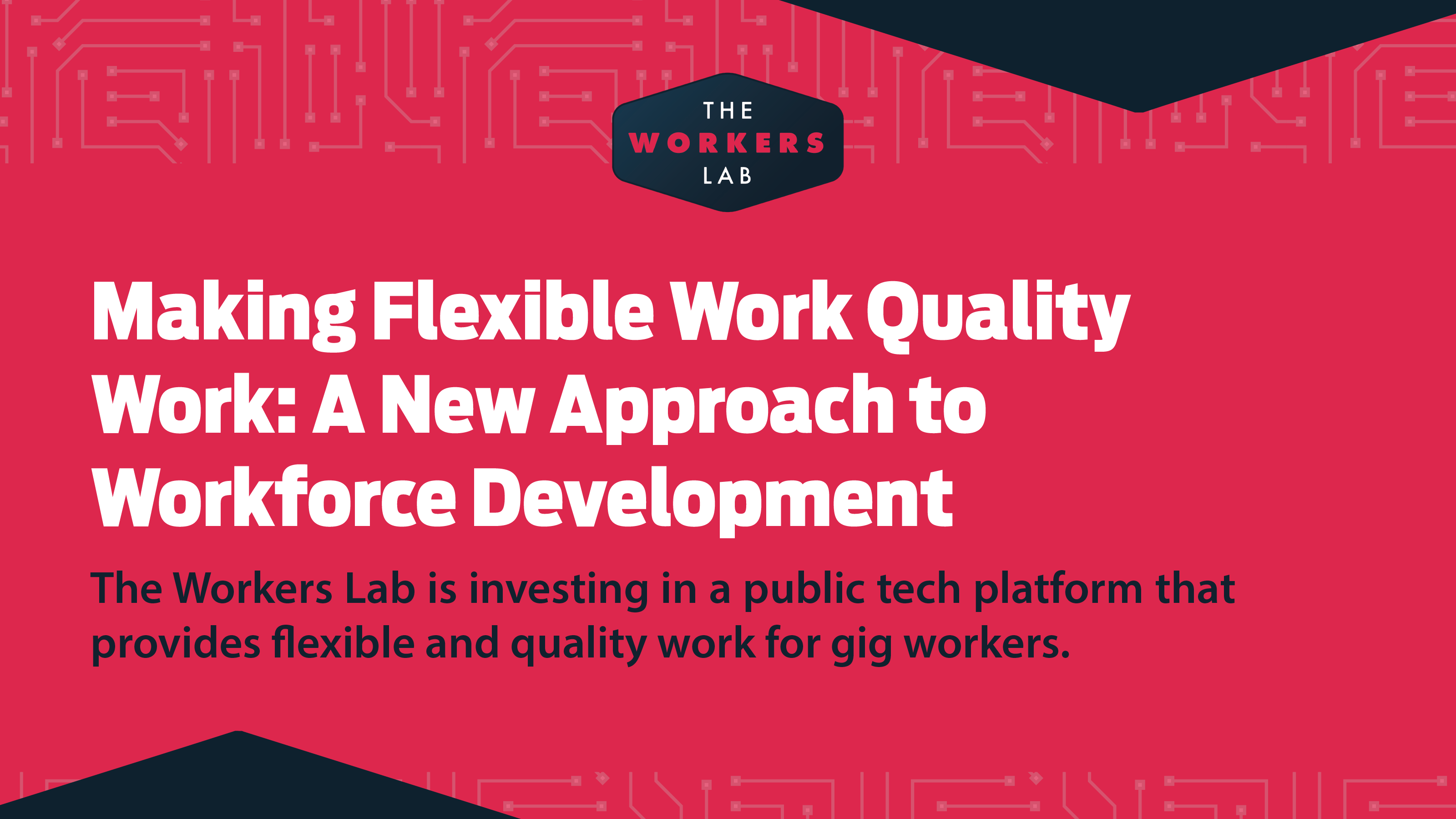As the gig economy continues to grow, we’re at a critical moment for supporting workers who want and need flexibility in their work because all the other aspects in their lives demands it, whether that's childcare, college classes, eldercare, a disability, health condition, interest in entrepreneurship, or more personal freedom and agency. Many important efforts are happening in this area and The Workers Lab is excited that our design sprint on quality flexible work continues to demonstrate promising results. This update shares some of our recent learnings as we prepare to further test the tech platform in even more cities.
The platform offers a worker-centered, public alternative in the marketplace for local workers seeking flexible work that’s also quality work. This means that the tech platform is fully informed and refined based on deep listening and learning directly from workers. Workers using the platform have autonomy over when and where they work and the type of work they do. Workers are also able to negotiate pay, garner access to benefits, be informed of their workplace protections, seek remedies from bad-acting employers, move up, and grow in their work.
At The Workers Lab, we believe that our workforce system should serve all workers regardless of status, background, or their need for flexible work. We also believe that all work — whether it is standard employment or gig and contract work — should allow workers flexibility without sacrificing quality. Our recent findings show that making flexible work, quality work can also make the workforce development system and programs more modern and inclusive.
The challenge we’re facing is that the current workforce system in the United States often prioritizes the interests of employers based on a belief that people are out of work because they don’t have the skills employers need. The system historically has provided services for people in standard 9-to-5 employment, and there’s little to no incentive within the current workforce system to serve workers who need more flexibility than a 9-to-5 job can offer. Over time, the term “workforce development” has come to describe a relatively wide range of activities, policies, and programs employed by geographies to create, sustain, and retain a viable workforce that can support current and future business and industry. Right now, the problem is that these workforce leaders, nonprofits, and to some extent the private tech platforms, are forced to operate outside of the established workforce development system because the system isn’t working for non-standard workers. While conversations continue at all levels of government about how to structure workforce development, it’s not likely that we will see a fundamental shift in the system soon. That void is where this design sprint fills a necessary and urgent gap for workers.
Since starting our sprint, we’ve learned from workers, worker advocates, employers, and local workforce development leaders themselves and discovered that this innovation holds promise for workers and employers alike, beyond what we could have imagined. In addition to making flexible work quality work, our efforts with this sprint aim to make the ways our nation develops workers more modern and inclusive. Here’s how:
#1 Accounting for All Workers' Skills and Potential Contributions
We believe that everyone has skills and abilities — and we strive to honor and dignify those skills. Traditional approaches to workforce development don’t fully consider whether a worker’s skill set could transfer easily from one role to another. Most workers have skills, experiences, and expertise that can be valuable for the local community and generate income for them and their families. For example, babysitting experience could be the baseline for finding future work as a lifeguard or after-school aide with additional support and training. Workers don’t always know what experiences to look for and our current systems all too often don’t help workforce leaders search for and help workers build off of those early experiences.
Non-standard workers and prospective employers can and should benefit from understanding that many skills might translate into new roles and responsibilities with training, coaching, and exposure. Every worker has a unique combination of skills, goals, and talents they can leverage in any given workplace. By leveraging technology, this design sprint is helping make those connections clear.
#2 Formalizing the “Non-Traditional” Skills and Potential Contributions of All Workers
We believe in the value of all workers and their skills. Let’s continue with the babysitting example. If our workforce leaders can begin to view something like babysitting less as an informal one-off service and more as a formative experience to build on, they can more effectively harness that type of work and ensure its quality in the short-term, while also developing that babysitter’s skills in preparation for longer-term work should they ever want or need it.
Using a more holistic and worker-centered approach to what work means and looks like today, the technology platform and local community-led model address the challenge of formalizing non-traditional skills to set workers up for future success. The platform is disrupting an outdated cultural norm that getting work is based far more on what you've done, versus what you can and want to do in the future.
The platform does this by providing a digital resume that updates in real-time as workers take on new roles and develop new skills. The platform also gives workers "badges" that supplement existing credentialing systems to help workers stand out to employers looking for new hires. For instance, in a city like Long Beach, CA, where workers and employers are already using the platform, a badge that shows a person is “willing and able to work on a boat” is helpful to employers in this area where the marine economy is vibrant. Badges like this also allow workers to articulate the workplaces where they feel comfortable furthering their agency and autonomy. Formalizing these kinds of skills and preferences can help workers and employers alike get work done in more worker-centered, tailored, and efficient ways.
#3 Expanding the Pool of Local Flexible Workers for Local Employers to Choose From and Vice Versa
We believe workers and employers are missing out on opportunities to work with each other. Right now, workers are spending a massive amount of time finding flexible work only to determine that it isn’t quality work, isn’t the right fit, or otherwise doesn’t meet their needs. Similarly, employers are spending a lot of time searching for workers to do part-time, seasonal, or other work requiring flexibility. Imagine the boost to local economies when this process becomes much more efficient while emphasizing quality?
Through the platform, local community groups are identifying a new pool of vetted, badged, and excited people who want to work flexibly without sacrificing quality. It then connects them with local employers in need of their talents. This dynamic is a win-win, particularly in a tight labor market.
As we think about other ways to expand access to the pool of talented flexible workers, the platform is modernizing our current system by making it easier for workforce development agencies to track wage increases and time employed for those engaged in non-standard work across multiple employers. The ability for workforce leaders to track and accurately report nonstandard workers’ employment and earnings through the technology could incentivize more workforce leaders to serve these workers and connect them with supports necessary to thrive over time. It also has the ability to provide additional nuanced metrics, such as how far a worker travels for work, their work progression and barriers, etc. that will help local workforce systems more effectively serve all workers.
As we move toward the official launch of pilots in several cities, we look forward to keeping you updated. We plan to share additional announcements related to our design sprint for quality flexible work over the next few months.
-Jun-06-2024-03-00-31-8398-PM.png?width=1800&height=1080&name=TWL%20Logo%201%20(1)-Jun-06-2024-03-00-31-8398-PM.png)

